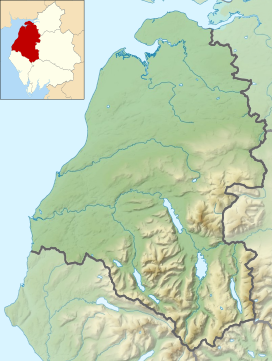Topography
The Western Fells occupy a triangular sector of the Lake District, bordered by the River Cocker to the northeast and Wasdale to the southeast. To the west, the hills diminish toward the coastal plain of Cumberland. At the central hub of the high country are Great Gable and its satellites, while two principal ridges fan out on either flank of Ennerdale—the western fells being, in effect, a great horseshoe around this long wild valley. [1] Burnbank Fell and the other Loweswater Fells form the extremity of the northern arm.
The Loweswater Fells have been compared [1] to the digits of a hand, radiating out southwestward from the "palm" centred on Loweswater village. From the west, these are Burnbank Fell, Blake Fell, Gavel Fell, Hen Comb and Mellbreak, the "thumb".
Burnbank Fell marks the northwestern perimeter of the Lakeland Fells, its feet set on the boundary of the National Park. Beyond lie the valley of the River Marrom and the industrial towns of the coastal plain. Beyond the park boundary is the low double top of Mockerkin How (810 ft) standing above Mockerkin Tarn. A natural water body, the Tarn is known for its water lilies, is stocked with eel, pike and perch, and is associated with several local legends, including that of a sunken town. [2]
The northeastern flanks of Burnbank Fell are much steeper, with some crags on the upper slopes overlooking Loweswater. Lower down the fellside is Holme Wood, an attractive background to views across the lake. Holme Beck runs down through the trees, forming the boundary between Burnbank Fell and Blake Fell to the south. High up in the woods is Holme Force, an attractive parallel pair of waterfalls. [3]
A west ridge drops from the summit across an easy grassy saddle to Owsen Fell (1,342 ft), generally considered a part of Burnbank Fell, [1] although some guidebooks differ. [4] Owsen Fell descends to the village of Lamplugh, with conifer plantations on its lower slopes. All drainage from Owsen Fell and the western slopes flows to the River Marron and ultimately the Derwent.
This page is based on this
Wikipedia article Text is available under the
CC BY-SA 4.0 license; additional terms may apply.
Images, videos and audio are available under their respective licenses.



